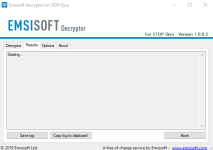- Aug 28, 2022
- 10
Hello,
A friend of mine have been infected by a ransomware but I can't find any information about it on the Internet.
I heard a lot about STOP/DJVU ransomware, but I don't know if this one is really related to this family or not.
I tried online sources (Emisoft, Nomoreransom, Avast, etc), but none of them look like to know this extension file.
I'm mainly looking for information, and to know if there is a way to decrypt the files. I'm familiar with IT and security in general, and sorry for my English, I'm french
An example : producteur.txt.stoponionmail.com.idRP6SdVt.stop
I ran Emisoft Decryptor for STOP/DJVU, and it's still on "Starting ..." after 10 minutes for 1 file.

I also have a WeTransfer link if someone wants the encypted file (no sensible info inside). Could it be useful to share the ransom note too ?
Thanks for your time fellows
A friend of mine have been infected by a ransomware but I can't find any information about it on the Internet.
I heard a lot about STOP/DJVU ransomware, but I don't know if this one is really related to this family or not.
I tried online sources (Emisoft, Nomoreransom, Avast, etc), but none of them look like to know this extension file.
I'm mainly looking for information, and to know if there is a way to decrypt the files. I'm familiar with IT and security in general, and sorry for my English, I'm french
An example : producteur.txt.stoponionmail.com.idRP6SdVt.stop
I ran Emisoft Decryptor for STOP/DJVU, and it's still on "Starting ..." after 10 minutes for 1 file.

I also have a WeTransfer link if someone wants the encypted file (no sensible info inside). Could it be useful to share the ransom note too ?
Thanks for your time fellows